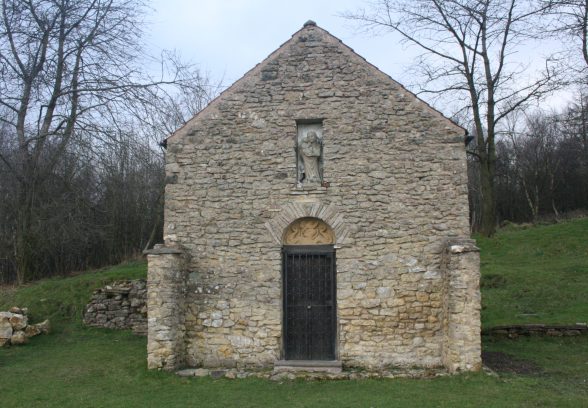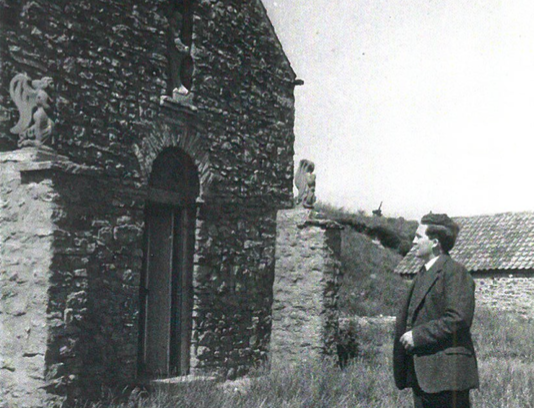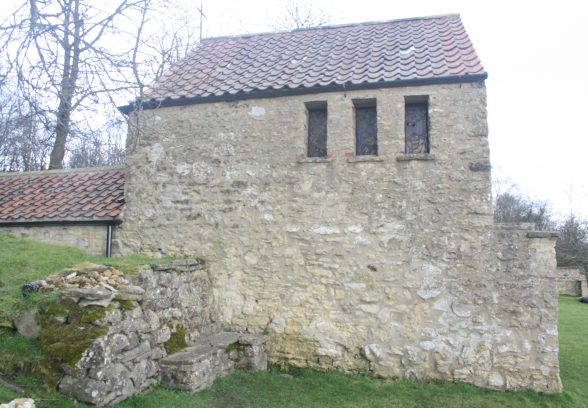This website uses cookies
This website uses cookies to enable it to function properly and to analyse how the website is used. Please click 'Close' to accept and continue using the website.






December 2017 - War Memorial Chapel, Oldstead, North Yorkshire
By Sam Hawksford White. In 1957, the sculptor John Bunting began to rebuild the ruins of a hillside farm to serve as a memorial chapel for those killed in the 1939-45 war. Although the artist produced figural sculpture for churches throughout his life, it is this non-denominational memorial that is his masterpiece, built without intervention from clients or building committees. As he remarked later, anything larger than the individual was capable of building and paying for himself would have risked a disunified structure, whereas, following this method, stone building, doorway and sculpture were able to form a single cohesive unit.
At Oldstead, the starting point was a ruined barn and farm house, left standing but unoccupied since before the Great War. In the summer of 1957, he began to excavate the collapsed rubble walls of the barn, cleaning each stone to be reused in the relaying of the elevations. As winter set in the chapel was roofed with pantiles brought from a local cottage that was being demolished, and subsequently work began on internal and external sculpture to adorn the rough walls.
First, two angels holding scrolls were mounted on slender stone buttresses to either side of the round-arched entrance. In the tympanum above the door was inset a relief panel illustrating Noah with a dove of peace; in the niche above this stands a serene Madonna and Child. In the west wall Bunting cut three narrow rectangular windows which he filled with stained glass depicting scenes from the story of Adam and Eve, illuminating the interior with coloured light, but otherwise leaving the masonry exposed, revealing the process of construction much as the sculptor leaves legible chisel marks on a finished work.
As built the interior contained a single free-standing sculptural piece, a recumbent figure of a soldier laid before a plain stone altar. If you choose to make a visit today, you will be able to see a much larger selection of works that have accumulated in the chapel since the death of the artist in 2002. In the interior, both the north and south elevations are centred on wooden crucifixes: the first carved in the artist’s local studio, the second during a travelling scholarship funded by the British Council to study seventeenth-century sculpture in Seville.
As the end of his time in Seville neared, the artist made a pilgrimage to the chapel built by the martyred French missionary Charles de Foucauld (1858-1916) at Béni Abbès in southern Algeria. Bunting returned to Yorkshire resolute in his intention to build and decorate his own chapel: writing that the way of life that had been laid down by St Benedict at Cassino had been given an outward manifestation in the long narrow cell that he found in the desert. At Béni Abbès the brother had built a similar structure, about forty feet long by six feet wide, using stones collected on the plateau, but chiefly of dried clay bricks, roofed with a palm leaf thatch. It was the ideal building for an ascetic, which was described favourably as ‘rustic, very poor, but harmonious’.
In the late 1950s, periodicals including L’art d’eglise advocated a rejuvenation of the archaic house-church model that demanded a ‘well-proportioned secular architecture offering from the beginning a good, genuinely human space’. The chapel should be read in this context: built simply, with material honesty, and never extending to a scale larger than that of the small house. At the same time, particularly during this month, we should recognise it as being representative of its decade, when religious art successfully renewed itself in response to the destructive power of conflict.
The chapel holds open days throughout the year, please see johnbunting.co.uk for details.
Sam Hawksford White is studying for the MSt in Building History at the University of Cambridge.
Look for past Buildings of the Month by entering the name of an individual building or architect or browsing the drop down list.

Become a C20 member today and help save our modern design heritage.